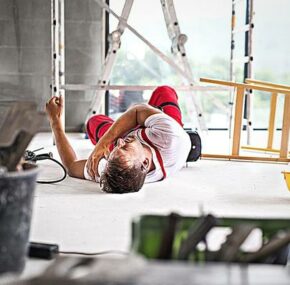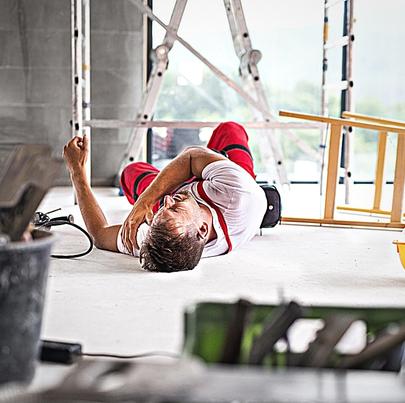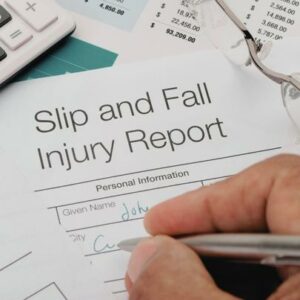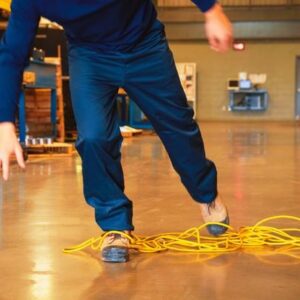Slip and fall cases are one of the leading causes of personal injury claims in Illinois, making them a significant concern for individuals and businesses alike. These incidents occur when someone slips, trips, or falls due to hazardous conditions on someone else’s property, such as wet floors, uneven surfaces, or insufficient lighting. The consequences can be severe, resulting in broken bones, head injuries, sprains, and other debilitating conditions. Victims often face medical expenses, lost wages, and pain and suffering, prompting them to seek compensation through personal injury claims. Recognizing the importance of maintaining safe premises, Illinois residents are increasingly holding negligent property owners accountable for their lack of maintenance and failure to address potential dangers.

What Are the Most Common Causes of a Slip and Fall?
Slip and fall accidents can occur in various settings and have multiple causes. Some of the most common causes of slip and fall incidents include:
- Hazardous or slippery surfaces: Wet or slippery floors, uneven or cracked pavement, loose rugs or carpets, and polished or waxed surfaces without proper warning signs are common causes of slips and falls.
- Weather conditions: You might slip and fall on ice, snow, rain, or even leaves. Any of these elements can create slippery conditions, particularly on outdoor surfaces such as sidewalks, parking lots, or entryways.
- Inadequate footwear: Wearing improper footwear, such as shoes with worn-out soles or high heels, can increase the risk of slipping and falling.
- Poor lighting: Insufficient lighting in walkways, stairwells, or parking lots can make it difficult to see potential hazards, increasing the chances of a slip and fall accident.
- Clutter or obstacles: Objects left in walkways, such as cords, boxes, or equipment, can pose tripping hazards and lead to falls.
- Lack of handrails or guardrails: Absence or inadequate installation of handrails or guardrails on staircases, ramps, balconies, or elevated areas can contribute to falls.
In addition, negligence in maintaining property, including failure to repair broken steps, loose handrails, or damaged flooring, can create dangerous conditions that contribute to slips and falls. Personal factors such as distractions, rushing, or not paying attention to the surroundings can also contribute to slip and fall incidents. Finally, failing to place warning signs for wet floors, uneven surfaces, or other potential hazards can increase the risk of accidents.
Steps to Take After a Slip and Fall Injury
Slip and fall accidents can happen unexpectedly and result in serious injuries. Whether it occurs at a public place, workplace, or someone else’s property, knowing the appropriate steps to take after such an incident is crucial. Prompt and appropriate action can not only help you obtain necessary medical attention, but also protect your rights in case of a legal claim. If you have been injured in a slip and fall accident, take the following steps:
Seek Immediate Medical Attention
The first and most crucial step after a slip and fall injury is to prioritize your health and safety. If you are seriously injured, immediately call for medical assistance or ask someone nearby to do so. Even if your injuries appear minor, it is still advisable to get a thorough medical evaluation. Some injuries may not be immediately apparent, and a medical professional can properly assess your condition and provide necessary treatment.
Document the Accident Scene
While still at the accident scene, if you are physically capable, gather evidence to support your claim. Take clear photographs of the area where the accident occurred, including any hazardous conditions, such as wet floors, broken stairs, or uneven surfaces. These photographs can serve as critical evidence later. Also, make a note of any contributing factors, such as poor lighting or lack of warning signs.
Report the Incident
After a slip and fall accident, you will need to notify the appropriate authority or property owner about the accident as soon as possible. If the incident occurs at a place of business, inform the manager or supervisor on duty. Make sure to provide a detailed account of what happened and request a written copy of the incident report. This report will help establish an official record of the accident, which may be useful during the claims process.
Gather Witness Information
If there were any witnesses present at the time of the accident, collect their names, phone numbers, and addresses. Witness testimony can play a crucial role in supporting your claim. In case you need to pursue legal action, having witnesses who can testify about the conditions, your injuries, and the negligence of the property owner can greatly strengthen your case.
Preserve Evidence
Preserve any physical evidence related to your slip and fall accident. This may include your clothing, shoes, or any other items that were damaged during the incident. Store them in a safe place and avoid altering or disposing of them. Additionally, keep all medical records, bills, and receipts related to your injuries and treatment. These documents will be important when seeking compensation for your medical expenses and other damages.
File an Insurance Claim
Finally, you will need to notify your insurance company about the slip and fall accident and file a claim. Provide them with all relevant information, including the incident report, medical records, and any other documentation related to the accident. Cooperate with their investigation and respond to any inquiries promptly. If the accident occurred on someone else’s property, the property owner’s insurance may be responsible for compensating you for your injuries.
Suffering a slip and fall injury can be a distressing experience, but taking appropriate steps after the incident can help protect your well-being and legal rights. You may also want to consider consulting a personal injury attorney experienced in slip and fall cases. They can provide you with valuable legal advice and guide you through the process. An attorney will evaluate the circumstances of your accident, help determine liability, and assist in building a strong case. They can also handle communications with insurance companies and negotiate a fair settlement on your behalf.
How to Prove Liability in a Slip and Fall Accident
In Illinois, as in many other jurisdictions, establishing liability in a slip and fall case requires the injured party to prove key elements. These elements are duty of care, breach of duty of care, causation, and damages/harm.
In slip and fall cases, the duty of care refers to the responsibility of the property owner or occupier to maintain reasonably safe conditions on their premises. In Illinois, property owners owe a duty of care to individuals who enter their premises, including visitors and customers. This duty entails taking reasonable steps to address known hazards and potential dangers that could cause harm to others.
To establish liability, the plaintiff must demonstrate that the defendant breached his or her duty of care. A breach occurs when the property owner fails to fulfill his or her duty by not maintaining safe premises or not adequately warning visitors about existing hazards. For example, you can sue if you slip and fall in a parking lot or other public space if an unmaintained hazard caused your accident. The standard of care may vary depending on the circumstances, however, such as the type of property and the visitor’s purpose for being on the property.
Causation is a crucial element in proving liability. In slip and fall cases, the plaintiff must establish a causal connection between the defendant’s breach of duty and the injuries sustained. This means demonstrating that the hazardous condition directly caused the accident and subsequent harm. In Illinois, the plaintiff must show that the defendant’s actions or inaction were a substantial factor in causing the injuries.
The element of harm relates to the actual injuries suffered by the plaintiff as a result of the slip and fall accident. Proving harm involves presenting evidence of physical, emotional, and financial damages. This can include medical records, bills, witness testimonies, and expert opinions, all of which help establish the extent of the plaintiff’s injuries and their impact on his or her daily life.
What Damages Might Be Awarded in a Slip and Fall Case?
In a slip and fall case, if liability is established, the injured party may be entitled to various types of damages. The specific damages awarded can vary depending on the jurisdiction and the circumstances of the case. However, the following are common types of damages awarded in a slip and fall case:
- Medical Expenses: Slip and fall accidents can result in various injuries, ranging from minor cuts and bruises to more severe fractures, head injuries, or spinal cord injuries. Damages may include reimbursement for medical bills, hospitalization costs, surgery expenses, prescription medications, rehabilitation fees, and any future medical treatment related to the accident.
- Pain and Suffering: Slip and fall accidents can cause physical pain and emotional distress. Damages may be awarded to compensate for the pain, suffering, and diminished quality of life experienced by the injured party. These damages are subjective and can vary based on the severity and long-term impact of the injuries.
- Lost Wages: If the slip and fall accident results in the injured person being unable to work, he or she may be entitled to compensation for lost wages. This includes not only the income lost during the recovery period, but also any future earning capacity that is affected by the injuries sustained.
- Rehabilitation and Therapy: In some cases, slip and fall accidents may require extensive rehabilitation, physical therapy, or occupational therapy. Damages can be awarded to cover these costs and assist in the injured party’s recovery and return to normal daily activities.
- Property Damage: If personal belongings, such as clothing, electronic devices, or eyeglasses, were damaged or destroyed as a result of the slip and fall accident, the injured party may seek compensation for the repair or replacement of these items.
- Loss of Consortium: In cases where the slip and fall accident causes significant injuries that impact the injured party’s relationship with his or her spouse, damages may be awarded to compensate for the loss of companionship, affection, and intimacy.
In some exceptional cases where the property owner’s actions were deemed willful, wanton, or malicious, punitive damages may be awarded. These damages aim to punish the defendant and deter similar behavior in the future.
How Can a Chicago Personal Injury Attorney Help Your Case?
After a slip and fall accident in Illinois, engaging the services of a personal injury lawyer can be highly beneficial. A personal injury attorney specializing in slip and fall cases will have a deep understanding of the relevant laws, regulations, and legal procedures in Illinois. He or she can provide you with guidance and explain your rights and options under the law. He or she will ensure that you meet all necessary deadlines and take the appropriate steps to protect your interests.
A skilled attorney will evaluate the circumstances of your slip and fall accident to determine the strength of your case. He or she will assess liability, analyze the evidence, and estimate the potential value of your claim. This evaluation will help you make informed decisions about how to proceed with your case.
The insurance company will go to great lengths to minimize the value of your claim. A personal injury attorney can handle all communications and negotiations with the insurance company on your behalf. He or she will fight for your rights and work to secure a fair settlement that compensates you for your injuries and damages.
If a fair settlement cannot be reached through negotiation, your attorney will be prepared to take your case to trial. He or she will develop a strong litigation strategy, collect thorough evidence, present your case effectively, and advocate for your rights in the courtroom. An attorney understands the types of damages that can be claimed in slip and fall cases and will work diligently to maximize your compensation.







